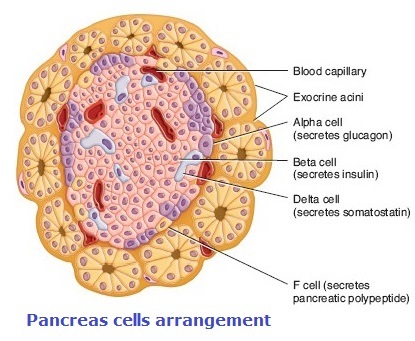Pancreatic cells control many important physiological functions in our body.
Unlike other glands in the body, the pancreas is both an endocrine and an exocrine gland.
Due to its endocrine function, it helps maintain blood glucose levels and body growth.
Through its exocrine functions, it helps in the digestion of food such that the nutrients are easily absorbed.
The pancreas is located below the stomach and secretes its exocrine enzymes into the small intestine.
Pancreatic Cells
There are broadly three types of cells in the pancreas as
- Acinar cells
- Islets of Langerhans.
- Pancreatic stellate cells

Acinar cells
These cells have an exocrine function and are arranged as lobules. They synthesize the digestive enzymes and secrete them into the intestine through the pancreatic duct.
They generally secrete enzymes like pancreatic amylase, trypsin, chymotrypsin, carboxypolypeptidase, pancreatic lipase, cholesterol esterase, and nucleases.
Pancreatic amylase helps in the digestion of complex carbohydrates into disaccharides and trisaccharides.
The enzyme trypsin and chymotrypsin break the proteins into peptides, and carboxypolypeptidase converts these polypeptides into individual amino acids.
The pancreatic enzyme lipase hydrolyzes fats into fatty acids and glyceraldehydes. The enzyme cholesterol esterase breaks down cholesterol esters.
Islets of Langerhans
These cells perform the endocrine function.
There are about 1 to 2 million islets of Langerhans in the pancreas around small capillaries.

They are called islets as they are scattered in the wide mass of acinar lobules. They are of 4 types:
- Alpha cells (α-cells)
- Beta cells (β-cells)
- Delta cells (δ-cells)
- F-cells or PP cells
Alpha cells: These cells secrete glucagon. They constitute about 17–25% of the total pancreatic islets of Langerhans cells.
The secreted glucagon hormone helps in the conversion of glycogen into glucose. It helps in the breakdown of glucagon in the liver and skeletal muscles and enhances glucose levels in the blood.
Beta cells: These cells secrete the hormone insulin. They constitute about 60–70% of the total pancreatic Langerhans cells.
Insulin, as you might have already known, decreases blood glucose levels. It enhances the formation of glycogen, which is stored in the liver.
Delta cells: These are the cells that secrete the hormone somatostatin. They constitute about 7–10% of the total islets of Langerhans cells. These hormones act as growth hormone-inhibiting hormones and help in the regulation of our body height.
F-cells: These cells secrete pancreatic polypeptides. These inhibit the contraction of the gall bladder and the secretion of digestive enzymes.
Also, interestingly, somatostatin inhibits the secretion of glucagon and insulin from the respective cells, while polypeptides from F-cells inhibit the secretion of somatostatin.
Pancreatic stellate cells (PSC)
These cells are located in the exocrine area of the pancreas. They comprise 4-7% of the total pancreatic cells. They help in the repair of injured portions of the pancreas. They also help in the destruction of tumor cells.
They exist in either form as activated PSC or quiescent PSC. Their role is shown in the picture below.

References: Principles of Anatomy and Physiology by G.Tortora
somatostatin does not act as a growth hormone, it is actually another name for growth hormone inhibiting hormone, so it antagonizes hGH.
Thanks so much,,its a good contribution to my research